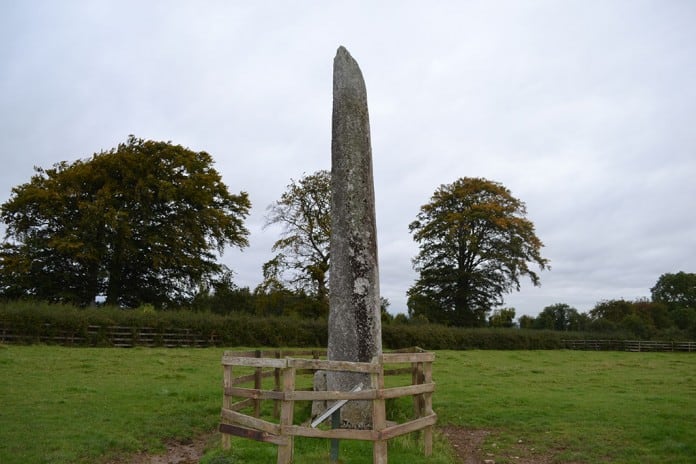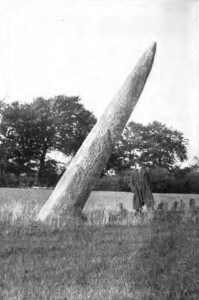
The Republic of Ireland is host annually to more visitors from overseas than it has permanent residents. This astonishing statistic owes much to the island’s stunning natural diversity and beauty, of course, as well as to the energy and culture of its great cities and the famed hospitality of the Irish people. Another reason cited for visiting Ireland, however, is its remarkable history, which is evidenced in the countless landmarks of the struggle for independence, and, going back much further, in the monuments of pagan and prehistoric times, such as the Celtic high crosses and the remarkable standing stones. In this short guide, we look at the Longstone of Punchestown Great in County Kildare, a menhir or standing stone thought to have been erected by the Beaker People.

Located in an otherwise unprepossessing field near the famous Punchestown Racecourse is the tallest and arguably most striking standing stone in Ireland. Part of a renowned circle of stones and locally known as the Longstone of Punchestown Great, this menhir was originally tilted, but in 1931 it toppled over and needed to be re-erected. It now stands straight, with a roughly square base which tapers to a wedge as it nears its apex. During the process of resetting the stone, it was found to be over seven metres in length and to weigh over nine tons. A Bronze Age burial cist was uncovered at the base of the granite stone, although this contained no human remains, grave goods or other ancient funerary relics. Scholars believe that it was constructed by the Beaker People. These were a late Neolithic and early Bronze Age people who migrated through Western Europe, Britain and Ireland from around 2700–1700 BC. Their name derives from the waisted pots or beakers that were used in their burial customs and may have had more prosaic functions such as being receptacles for drinks. The Beaker folk are no longer believed by most historians to have been a distinct and separate people, but their pots, which have been found at megalithic sites all over Europe, spread as a result of trade and, of course, migration.
Significant – and occasionally fierce – debate surrounds the exact purpose of the stones. One school of thought believes that they were burial markers, but relatively few of them have been excavated, so the location of a burial cist at the Punchestown site, for instance, cannot be considered conclusive proof of this theory, especially since no other funeral artefacts were identified beneath the stone. That said, burial remains have been found nearby and at other stones in the group to which the Punchestown stone belongs, such as at Forenaghts Great, which makes it impossible to eliminate the burial marker theory. Others contend that the stones were intended as sacred monuments representing cult beliefs, to propitiate gods or as sacrificial altars. Still others argue that they were boundary or territorial markers.
No less colourful is the folklore attaching to the stones generally and to the Punchestown stone in particular. For example, according to local legend, the stone was hurled by the mythical Irish giant and warrior Fionn MacCumhaill in a show of strength. Alternatively, it is said that he threw it at his wife in a fit of fury, but he missed her and the stone landed in its current location! Another legend relates that Viscount Allen wanted the stone for his mansion, so he had oxen yoked up to pull it from the ground. They could only pull it so far and, frustrated, the Viscount decided to abandon the stone at the precarious angle it held until 1931. The Welsh theologian Gerald of Wales mentions the stone in his journal “Topographia Hibernica”, which comprehensively narrates his 12th-century tour of southern Ireland. In this he says that the local people believed that giants had “brought it from the furthest parts of Africa into Ireland”.
If you are interested to see a menhir or standing stone erected by the Beaker People and decide to visit County Kildare to explore the Longstone of Punchestown, you will find it clearly signposted and the local people will be delighted to give you additional directions. You should be aware, though, that access to the site is difficult and there is no clear path. The stone is surrounded by a small wooden fence, which a minority of commentators claim mars the overall experience.
As mentioned above, the Longstone of Punchestown is part of a group of standing stones which form a rough circle of approximately five kilometres in diameter. The other stones, such as the standing stone/menhir at Kilgowan or that at Craddockstown, and their adjacent grounds, have fascinating stories and are worthy of a detour if you plan a trip to explore the menhirs. There are also other archaeological landmarks in the county, unconnected with the Beaker People, which will be of equal interest to history buffs. We hope to welcome you soon.

